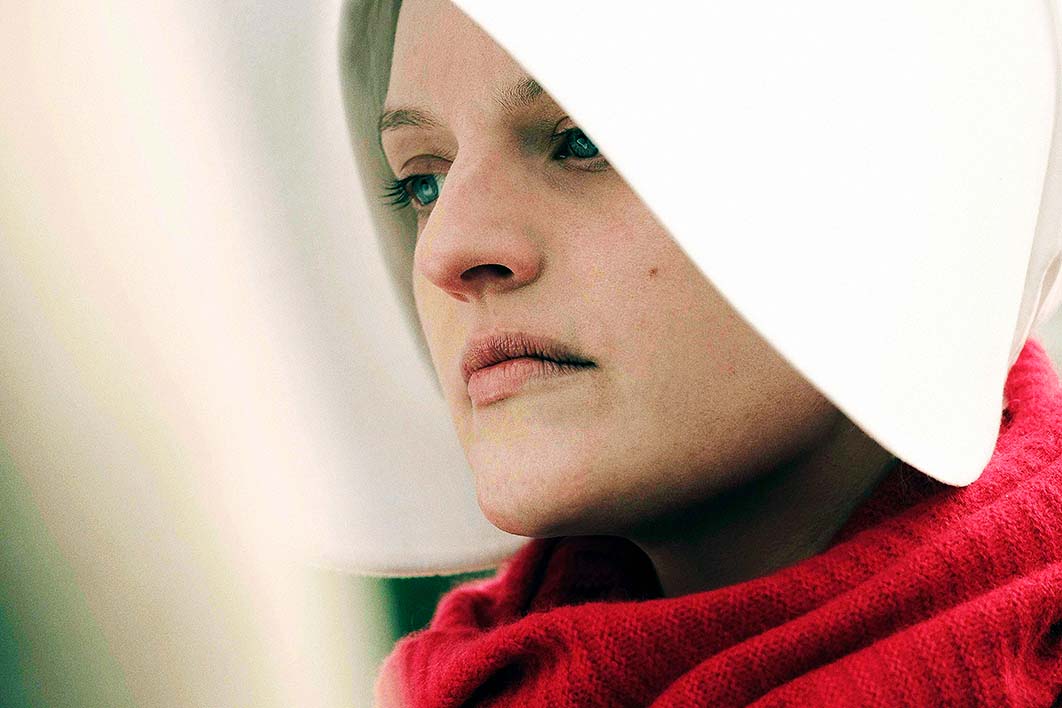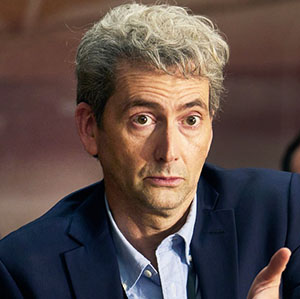A scene from the first episode of the new television version of The Handmaid’s Tale features the ritual shaming of a gang-rape victim. As the young woman recalls her experience, a steadily rising chant of denunciation comes from the circle of listeners – “Her fault,” “She led them on,” “Teach her a lesson” – while a shadowy figure approaches from behind the victim and fetches her a mighty swipe across the side of the head.
Backlit in radiant daylight, this figure will be recognisable to many viewers by the distinctive aura of tight curls around her head. It is Margaret Atwood, making a brief appearance as if to put her stamp of authentication on the new dramatisation of her novel. If there is a flaw in this poised and trenchant literary work, though, it is in the author’s inability to resist delivering that extra, gratuitous swipe.
In Volker Schlöndorff’s 1990 film version, starring Natasha Richardson and scripted by Harold Pinter, the scene is more naturalistic and restrained. The girls who form the accusing chorus are younger novices dressed in white, still not fully schooled in the reactions they are required to perform. It is a test for them, part of their gradual introduction to the roles they must play once they graduate from this bizarre academy.
In this television series, made by production company Hulu, showrunner Bruce Miller gives the drama a harder edge. Indoctrination, enforced with a cattle prod by the instructor, is immediate, and the students already wear the distinctive scarlet habits and white starched bonnets of the Handmaids. They know the lines they must speak and the expressions they must wear (and not wear) on their faces.
As fertile women in a society stricken with widespread infertility, their role is to bear children to the Commanders, men of rank whose wives are sterile. Many of the graduating Handmaids, including the penitent in the shaming scene, are familiar with the more extreme punishments for insubordination of any kind.
Perhaps it is unnecessary now to offer audiences any more gradual introduction to the horrors of Atwood’s world. Rape victims suffer atrocious punishments in Pakistan and Saudi Arabia. On 6 July, the very day The Handmaid’s Tale was made available in Australia through SBS On Demand, a nineteen-year-old was sentenced to thirty years’ imprisonment in El Salvador for failing to prevent the stillbirth of the baby conceived when she was raped.
In published commentaries, Atwood is insistent that the gruesome lynching scene in the first episode has real-life precedents – she cites one from the French Revolution and another recorded by Zola in his 1885 novel Germinal, in which a mob of striking miners tear their employer to pieces with their bare hands. If you have the stomach for it, you can find reports of many more recent examples from Chechnya, the Central African Republic and India.
While it evokes the aesthetics and social codes of seventeenth-century puritan America, The Handmaid’s Tale now seems alarmingly plausible as a vision of the future United States. Instead of fighting for an ever more open society, “progressives” in Trump’s America find themselves engaged in a rearguard action as moves are made to put reproductive control into the hands of lawmakers. As Atwood herself commented in a recent essay for the New York Times: “In the wake of the recent American election, fears and anxieties proliferate. Basic civil liberties are seen as endangered, along with many of the rights for women won over the past decades, and indeed the past centuries.”
The progressive illusion is the most powerful theme in her novel, and the flashback approach works especially well in television. How did things get to be like this? Hasn’t it all gone backwards? For those who thought liberation was a one-way trip, Atwood’s tale is a stern reminder that cultural climates are subject to radical turbulence. The world can turn both quickly and comprehensively, and television is the ideal medium for portraying the reversal.
The free and easy dialogue in the flashback scenes, the vivid and spontaneous play of human behaviour, is set against the muted and formal patterns of demeanour that belong to a society under total control. It’s a form of totalitarianism that is primarily social and cultural rather than political. “The personal is political” is a feminist rallying cry, but here the personal defines the political.
If Atwood sometimes overplays her hand in staking out the dramaturgy of victims and persecutors in the novel, this is less of a problem in the televised version once we have got past the more lurid scenes in the first episode. This is not a drama about violent events, but about codes of behaviour.
Ultimately, what is proscribed is human communication itself. The stringent choreographic requirements of “the ceremony,” in which the Commander attempts to impregnate the Handmaid, are of the essence. There will be no kissing, no embrace, no eye contact and no privacy. It is a contract that binds the powerful and the powerless alike. When the Commander, played by Joseph Fiennes, tries to break through the constraints, he does so by resorting to the lighter confines of a Scrabble game. Sitting across the table from his Handmaid, Offred, he can instigate an exchange of letters, then words, then glances and lastly, perhaps, some trust.
Time and again we see such tentative invitations to trust, but they are always misplaced. The Handmaids walk in pairs. “I spy on her; she spies on me,” Offred comments. With each of these partnerships, there are cautious explorations of the potential for breaking with protocol and forging an illicit alliance, but such explorations are always themselves double-edged. Are they tests? Lures to betrayal?
A spin-off from the period genre of the comedy of manners, The Handmaid’s Tale is a drama of manners in which the codes are so strictly enforced that every exchange is fraught with potentially dangerous tensions. In the household to which Offred is assigned, the enforcer-in-chief is the Commander’s wife, Serena Joy, played by Australian actress Yvonne Strahovski. This is a clever piece of casting. Strahovski, whose roles in action films have created a fan following, has an intimidating physical presence, but here she also displays some fine psychological acuity in navigating between formal demeanour, calculated menace and a genuinely human response.
The work of casting directors is not often acknowledged, but so often they are the making or breaking of television drama. Here, Russell Scott and Sherry Thomas (whose previous experience includes five years on Breaking Bad) do an impeccable job. It’s a cast of few principals and many extras, but the same quality of attention is given to the choice of every face that comes before the camera.
Fiennes makes the Commander a much more agile and unpredictable personality than he is in Atwood’s novel, where he is a stereotyped silver-haired patriarch. Ann Dowd as Aunt Lydia, the Handmaids’ chief instructress and controller, takes a character who is no more than a series of tedious rants on the page, and brings every statement alive with manipulative ingenuity.
Laurels in any review should go to Elisabeth Moss, as Offred, who appears in almost every scene. She has the face of an innocent, wide-eyed and classically symmetrical. Much of the time it is framed in the translucent cone of white linen that is the Handmaids’ distinguishing head-dress. The camera, and we who are watching what it sees, tracks this face in its every register: wearing the required expression when she is under observation, sometimes devoid of all expression, sometimes betraying the emotional turmoil that is always threatening to overwhelm her. Moss does fifty shades of fear, from apprehension to outright panic.
The stars of the show, though, are the production designers (Julie Berghoff and Andrew Stearn) and art directors (Evan Webber and Nicolas Lepage). Atwood is a highly visual writer. Her chapters start with the particulars of setting and decor for each scene, and these are realised with extraordinary imaginative discipline. Interior tableaux, with shafts of soft daylight filtering through squared windows and domestic figures in linen caps bending over their work, evoke the paintings of the Dutch masters. Handmaids walking in pairs in their sculpted red-and-white costumes are in every exterior shot, sometimes seen from a distance or from above.
Aerial shots reinforce the sense of formal design that imprisons the human inhabitants and determines their movements. Every sequence here is a classical composition of colour, light and form. This horrible world is mesmerisingly beautiful. •




